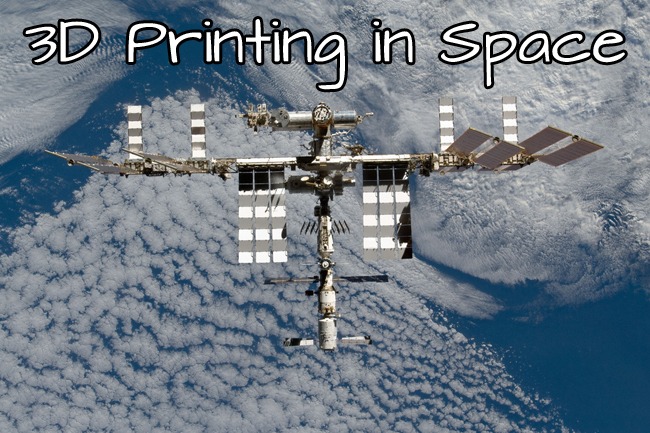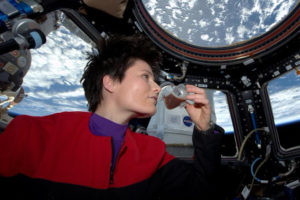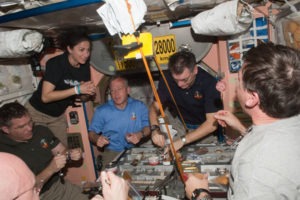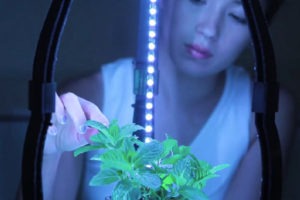
Have you seen the pictures floating around of the astronaut enjoying an espresso on the International Space Station? It turns out that the delicious brewed beverage was in a 3D printed cup that had been carefully designed to keep the liquid from floating around the microgravity environment on the Space Station. It was shaped so that the coffee would be held together with enough surface tension to keep it from floating away.
3D printing is proving more and more useful for space travel. Even if it hadn’t been used to make a coffee cup, 3D printing offers a lot of opportunities for improving the work and living situations for astronauts on the ISS. It also has the potential to expand what astronauts can do in space by putting more tools at their disposal.

Let’s start from the beginning. On November 24, 2014, the very first item was 3D printed on the International Space Station. This successful test made history and ushered in the beginning of a new age in space exploration.
The extruder plate (part of the 3D printer itself) is so important because it shows that it IS possible to 3D print items at very low or zero gravity. This will vastly change the future of space travel.
If astronauts can use 3D printing while flying through space to create replacement parts, then space flights and missions can last much longer because they’ll be able to self-repair almost infinitely.
Having the ability to create replacement parts means less cargo room will need to be reserved for tools that may or may not be used. This leaves more space for other kinds of supplies needed for long-term missions—more food or items astronauts would need after landing on the moon or another planet.
NASA is using 3D printing to help advance space travel in other ways too.
There are ways to 3D print foods to feed astronauts aboard the ISS or, say, on a manned trip to Mars. Although NASA lists a lot of foods available to astronauts, each meal must be carefully prepared ahead of time to avoid spoiling that could sicken the astronauts.

3D printing food in space (NASA says the D stands for “dining”) can vastly expand an astronaut’s diet on “long duration space missions.” Food is a major limiting factor right now in terms of how long a manned space flight can last, and NASA’s study into 3D printing food looks to change that. 3D printed food also expands the KINDS of food available, which can boost morale.
Another option is to 3D print tiny biodomes for growing small plants. While this isn’t practical for feeding a whole spaceship full of astronauts, it can supplement their diets, improve their morale by giving them reminders of their home planet, and can even help with air quality.
These little biodomes can also help when we get to the point of extended missions or actually living on Mars. With contour crafting looking to build colonies on Mars, it’s important to set up sustainable food sources to feed the colonists.

Contour crafting is just 3D printing on a large scale: landing strips, houses, and other necessary infrastructure for life on Mars. As this technology, pioneered by NASA and Khoshnevis, advances, it becomes more likely that humans can establish a colony on Mars and further our research there.
NASA is working on using materials readily available on Mars to 3D print this infrastructure. If a robot can get this work done ahead of time, it will be easier to come in and build a colony on top of it.
The contour crafting robot will (probably) make use of materials readily available and build structures using a compound made up primarily of Martian dirt. NASA is also looking at doing the same thing with moon dust. They gave a replication of the dust to Washington State University to test out whether or not this is possible.
Researchers managed to melt and then extrude the regolith to create small objects with the consistency of glass jars. The researchers from Washington State suggested that adding a titanium powder to the regolith could make a stronger material, but it hasn’t been tested yet, and the practicality is questionable.
If the moon dust requires an addition of titanium, it means that trips to establish infrastructure on the moon would have to include large amounts of the titanium powder to make the trip worth taking.
Once NASA figures it out, though, Contour crafting on the moon could create a research base or refueling station (or both) for ships on the way to more distant locations, like that Mars colony. Imagine stopping for a layover on the moon instead of in New York or Atlanta.
What are your favorite advances that 3D printing is bringing to space travel? Did I leave anything out that you think should be included? Leave a comment to let me know!


